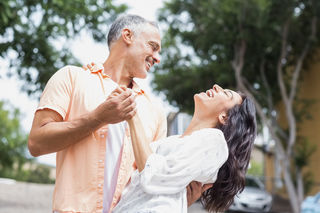Aging
Want to Keep Your Brain Youthful? You Should Be Dancing
Dancing may reverse signs of aging in the human brain, new research shows.
Posted August 26, 2017
We all know that the songs of our youth are like time capsules that can make us feel young again. As we grow older, most of us typically experience a decline in mental and physical fitness, which can exacerbate conditions such as dementia and Alzheimer's disease. But there is good news: A growing body of clinical studies find that aerobic exercise — especially in the form of learning dance routines — can help maintain the youthfulness of your body, mind, and brain across a lifespan.
The latest research shows that dancing has surprising anti-aging brain benefits. MRI brain scans from a 2017 study on dancing showed that age-related degeneration in brain structure improved dramatically when people (with an average age of 68) participated in a weekly course to learn choreographed dance routines. These findings were published in the journal Frontiers in Neuroscience.

For this study, researchers from the German Center for Neurodegenerative Disease and Institute for Sports Science in Magdeburg, Germany wanted to compare the neuroprotective benefits of moderate-to-vigorous physical activity (MVPA) alongside the brain benefits of taking dance classes. According to the authors:
"In sum, the present results indicate that both dance and fitness training can induce hippocampal plasticity in the elderly, but only dance training improved balance capabilities."
The researchers found that both regular aerobic physical activity (walking, riding a stationary bike, using an elliptical trainer) and dancing increased hippocampal gray matter volume. This is notable because the hippocampus — which plays a significant role in learning and memory — is particularly vulnerable to age-related decline marked by a loss of gray matter volume.
Dancing Boosts Brain Volume and Improves Functional Connectivity

Previous research has shown that learning and memorizing choreographed dance routines or tapping your fingers to musical beats presents unique challenges that promote neural activity and functional connectivity between multiple brain regions.
The authors of a 2016 study on the neural benefits of dancing, published in the Journal of Cognitive Psychology. concluded:
"Sport dancers had increased body intelligence sensitivity compared with matched controls. In addition, the characteristics of dance, including physical movement in accordance with rhythm perception, might be associated with increased brain activity in the somatosensory and rhythm perception networks."
Another study, from 2014, used functional magnetic resonance imaging (fMRI) to scan participants' brains as they tapped their fingers to a beat, while listening to previously unheard songs with drum breaks that created changes in musical rhythm. Notably, the drum breaks within each song activated the left cerebellum, the right inferior frontal gyrus (RIFG), and the superior temporal gyri (STG) bilaterally. The researchers speculate that these brain areas may be recruited during rhythmic musical engagement as part of a predictive feed-forward control that involves the cerebellum and cortical areas. These findings were published in the journal Neuroscience.
Kathrin Rehfeld, lead author of the recent dance study from the German Center for Neurodegenerative Diseases, said in a statement:
“Exercise has the beneficial effect of slowing down or even counteracting age-related decline in mental and physical capacity. In this study, we show that two different types of physical exercise (dancing and endurance training) both increase the area of the brain that declines with age. In comparison, it was only dancing that lead to noticeable behavioral changes in terms of improved balance."
The researchers hypothesize that the improvements in balance may be linked to the complexity of coordinating foot steps, arm patterns, along with speed and rhythm changes that are involved with learning a mixed genre of dance styles that included Line Dancing, Jazz, Square, and Latin-American, all of which were part of the 18-month dancing seminar. Additionally, study participants were asked to perform specific dance routines in recitals without any cues from the instructor. The added challenge of pushing beyond one's comfort zone during these performances may have accounted for some of the specific hippocampal benefits observed in the dancing group.
The multidisciplinary research team in Magdeburg, Germany is adapting their neuroscience-based findings to create fitness programs that incorporate dance routines and music therapy in an effort to maximize the anti-aging brain benefits of physical activity. “Dementia patients react strongly when listening to music," Rehfeld said. "We want to combine the promising aspects of physical activity and active music making in a feasibility study with dementia patients."
The Bee Gees Were Right: You Should Be Dancing
Rehfeld leaves us with some practical advice that might inspire you to get down, boogie oogie oogie till you just can't boogie no more:
"I believe that everybody would like to live an independent and healthy life, for as long as possible. Physical activity is one of the lifestyle factors that can contribute to this, counteracting several risk factors and slowing down age-related decline. I think dancing is a powerful tool to set new challenges for body and mind, especially in older age."
References
Kathrin Rehfeld, Patrick Müller, Norman Aye, Marlen Schmicker, Milos Dordevic, Jörn Kaufmann, Anita Hökelmann, Notger G. Müller. Dancing or Fitness Sport? The Effects of Two Training Programs on Hippocampal Plasticity and Balance Abilities in Healthy Seniors. Frontiers in Human Neuroscience, 2017; 11 DOI: 10.3389/fnhum.2017.00305
Kim, Young Jae, Eun Joo Cha, Kyoung Doo Kang, Bung-Nyun Kim, and Doug Hyun Han. "The effects of sport dance on brain connectivity and body intelligence." Journal of Cognitive Psychology 28, no. 5 (2016): 611-617. DOI: 10.1080/20445911.2016.1177059
Danielsen, A., M. K. Otnaess, Jimmy Jensen, S. C. R. Williams, and B. C. Østberg. "Investigating repetition and change in musical rhythm by functional MRI." Neuroscience 275 (2014): 469-476. DOI: 10.1016/j.neuroscience.2014.06.029




